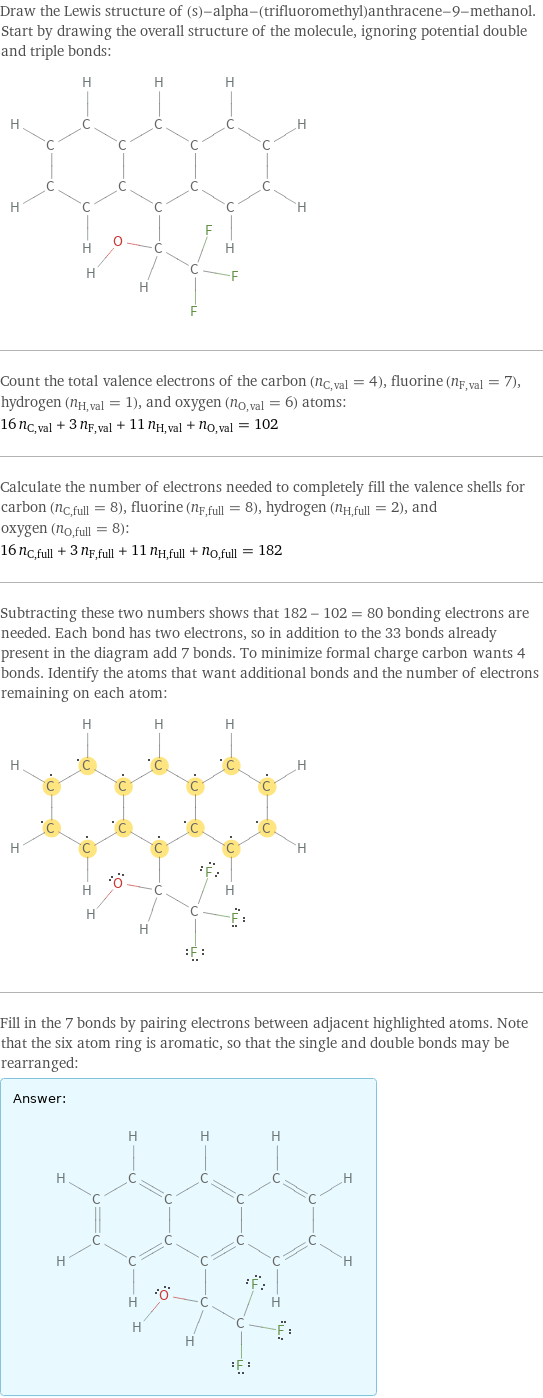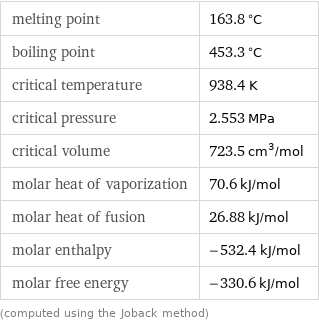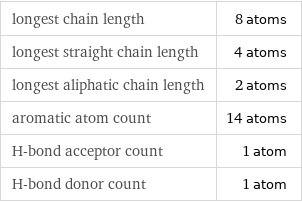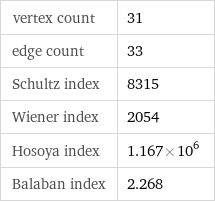Input interpretation

(s)-alpha-(trifluoromethyl)anthracene-9-methanol
Basic properties
(F)F)O InChI identifier | InChI=1/C16H11F3O/c17-16(18, 19)15(20)14-12-7-3-1-5-10(12)9-11-6-2-4-8-13(11)14/h1-9, 15, 20H/t15-/m0/s1 InChI key | ICZHJFWIOPYQCA-HNNXBMFYSA-N](../image_source/52ac88957439144cb544007bb029b685.png)
molar mass | 276.3 g/mol formula | C_16H_11F_3O empirical formula | F_3C_16O_H_11 SMILES identifier | C1=CC2=CC3=CC=CC=C3C(=C2C=C1)[C@@H](C(F)(F)F)O InChI identifier | InChI=1/C16H11F3O/c17-16(18, 19)15(20)14-12-7-3-1-5-10(12)9-11-6-2-4-8-13(11)14/h1-9, 15, 20H/t15-/m0/s1 InChI key | ICZHJFWIOPYQCA-HNNXBMFYSA-N
Lewis structure

Draw the Lewis structure of (s)-alpha-(trifluoromethyl)anthracene-9-methanol. Start by drawing the overall structure of the molecule, ignoring potential double and triple bonds: Count the total valence electrons of the carbon (n_C, val = 4), fluorine (n_F, val = 7), hydrogen (n_H, val = 1), and oxygen (n_O, val = 6) atoms: 16 n_C, val + 3 n_F, val + 11 n_H, val + n_O, val = 102 Calculate the number of electrons needed to completely fill the valence shells for carbon (n_C, full = 8), fluorine (n_F, full = 8), hydrogen (n_H, full = 2), and oxygen (n_O, full = 8): 16 n_C, full + 3 n_F, full + 11 n_H, full + n_O, full = 182 Subtracting these two numbers shows that 182 - 102 = 80 bonding electrons are needed. Each bond has two electrons, so in addition to the 33 bonds already present in the diagram add 7 bonds. To minimize formal charge carbon wants 4 bonds. Identify the atoms that want additional bonds and the number of electrons remaining on each atom: Fill in the 7 bonds by pairing electrons between adjacent highlighted atoms. Note that the six atom ring is aromatic, so that the single and double bonds may be rearranged: Answer: | |
Estimated thermodynamic properties

melting point | 163.8 °C boiling point | 453.3 °C critical temperature | 938.4 K critical pressure | 2.553 MPa critical volume | 723.5 cm^3/mol molar heat of vaporization | 70.6 kJ/mol molar heat of fusion | 26.88 kJ/mol molar enthalpy | -532.4 kJ/mol molar free energy | -330.6 kJ/mol (computed using the Joback method)
Units

Quantitative molecular descriptors

longest chain length | 8 atoms longest straight chain length | 4 atoms longest aliphatic chain length | 2 atoms aromatic atom count | 14 atoms H-bond acceptor count | 1 atom H-bond donor count | 1 atom
Elemental composition

Find the elemental composition for (s)-alpha-(trifluoromethyl)anthracene-9-methanol in terms of the atom and mass percents: atom percent = N_i/N_atoms × 100% mass percent = (N_im_i)/m × 100% Plan: • Write the chemical formula and gather atomic masses from the periodic table. • Determine values for N_i, m_i, N_atoms and m using these items. • Finally, compute the percents and check the results. Write the chemical formula: C_16H_11F_3O Use the chemical formula, C_16H_11F_3O, to count the number of atoms, N_i, for each element and find the total number of atoms, N_atoms: | number of atoms F (fluorine) | 3 C (carbon) | 16 O (oxygen) | 1 H (hydrogen) | 11 N_atoms = 3 + 16 + 1 + 11 = 31 Divide each N_i by N_atoms to calculate atom fractions. Then use the property that atom fractions must sum to one to check the work: | number of atoms | atom fraction F (fluorine) | 3 | 3/31 C (carbon) | 16 | 16/31 O (oxygen) | 1 | 1/31 H (hydrogen) | 11 | 11/31 Check: 3/31 + 16/31 + 1/31 + 11/31 = 1 Compute atom percents using the atom fractions: | number of atoms | atom percent F (fluorine) | 3 | 3/31 × 100% = 9.68% C (carbon) | 16 | 16/31 × 100% = 51.6% O (oxygen) | 1 | 1/31 × 100% = 3.23% H (hydrogen) | 11 | 11/31 × 100% = 35.5% Look up the atomic mass, m_i, in unified atomic mass units, u, for each element in the periodic table: | number of atoms | atom percent | atomic mass/u F (fluorine) | 3 | 9.68% | 18.998403163 C (carbon) | 16 | 51.6% | 12.011 O (oxygen) | 1 | 3.23% | 15.999 H (hydrogen) | 11 | 35.5% | 1.008 Multiply N_i by m_i to compute the mass for each element. Then sum those values to compute the molecular mass, m: | number of atoms | atom percent | atomic mass/u | mass/u F (fluorine) | 3 | 9.68% | 18.998403163 | 3 × 18.998403163 = 56.995209489 C (carbon) | 16 | 51.6% | 12.011 | 16 × 12.011 = 192.176 O (oxygen) | 1 | 3.23% | 15.999 | 1 × 15.999 = 15.999 H (hydrogen) | 11 | 35.5% | 1.008 | 11 × 1.008 = 11.088 m = 56.995209489 u + 192.176 u + 15.999 u + 11.088 u = 276.258209489 u Divide the mass for each element by m to calculate mass fractions. Then use the property that mass fractions must sum to one to check the work: | number of atoms | atom percent | mass fraction F (fluorine) | 3 | 9.68% | 56.995209489/276.258209489 C (carbon) | 16 | 51.6% | 192.176/276.258209489 O (oxygen) | 1 | 3.23% | 15.999/276.258209489 H (hydrogen) | 11 | 35.5% | 11.088/276.258209489 Check: 56.995209489/276.258209489 + 192.176/276.258209489 + 15.999/276.258209489 + 11.088/276.258209489 = 1 Compute mass percents using the mass fractions: Answer: | | | number of atoms | atom percent | mass percent F (fluorine) | 3 | 9.68% | 56.995209489/276.258209489 × 100% = 20.63% C (carbon) | 16 | 51.6% | 192.176/276.258209489 × 100% = 69.56% O (oxygen) | 1 | 3.23% | 15.999/276.258209489 × 100% = 5.791% H (hydrogen) | 11 | 35.5% | 11.088/276.258209489 × 100% = 4.014%
Elemental oxidation states

The first step in finding the oxidation states (or oxidation numbers) in (s)-alpha-(trifluoromethyl)anthracene-9-methanol is to draw the structure diagram. Next set every oxidation number equal to the atom's formal charge: In (s)-alpha-(trifluoromethyl)anthracene-9-methanol hydrogen is not bonded to a metal with lower electronegativity, so it will have an oxidation state of +1. Any element bonded to hydrogen gains the bonding electrons, decreasing their oxidation state by 1 for every bond: With hydrogen out of the way, look at the remaining bonds. There are 3 carbon-fluorine bonds, 1 carbon-oxygen bond, and 18 carbon-carbon bonds. For each of these bonds, assign the bonding electrons to the most electronegative element. First examine the carbon-fluorine bonds: element | electronegativity (Pauling scale) | C | 2.55 | F | 3.98 | | | Since fluorine is more electronegative than carbon, the electrons in these bonds will go to fluorine. Decrease the oxidation number for fluorine in every highlighted bond (by 1 for single bonds, 2 for double bonds, and 3 for triple bonds), and increase the oxidation number for carbon accordingly: Next look at the carbon-oxygen bond: element | electronegativity (Pauling scale) | C | 2.55 | O | 3.44 | | | Since oxygen is more electronegative than carbon, the electrons in this bond will go to oxygen: Next look at the carbon-carbon bonds: element | electronegativity (Pauling scale) | C | 2.55 | C | 2.55 | | | Since these elements are the same the bonding electrons are shared equally, and there is no change to the oxidation states: Now summarize the results: Answer: | | oxidation state | element | count -2 | O (oxygen) | 1 -1 | C (carbon) | 9 | F (fluorine) | 3 0 | C (carbon) | 6 +1 | H (hydrogen) | 11 +3 | C (carbon) | 1
Orbital hybridization

First draw the structure diagram for (s)-alpha-(trifluoromethyl)anthracene-9-methanol, and for every non-hydrogen atom, count the σ-bonds. Note that double and triple bonds consist of one σ-bond together with one or two π-bonds: Identify those atoms with lone pairs: Find the steric number by adding the lone pair count to the number of σ-bonds: Consult the following chart to determine the hybridization from the steric number: steric number | hybridization 2 | sp 3 | sp^2 4 | sp^3 5 | dsp^3 6 | d^2sp^3 7 | d^3sp^3 Now assign the hybridization for each atom: Answer: | |
Topological indices

vertex count | 31 edge count | 33 Schultz index | 8315 Wiener index | 2054 Hosoya index | 1.167×10^6 Balaban index | 2.268